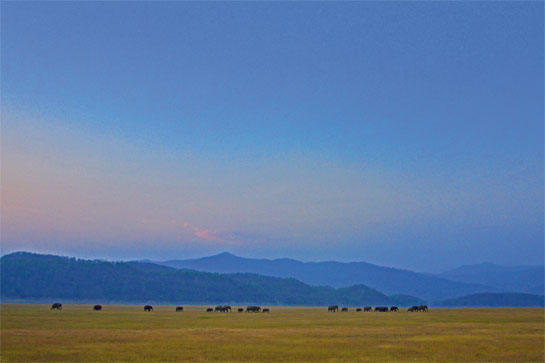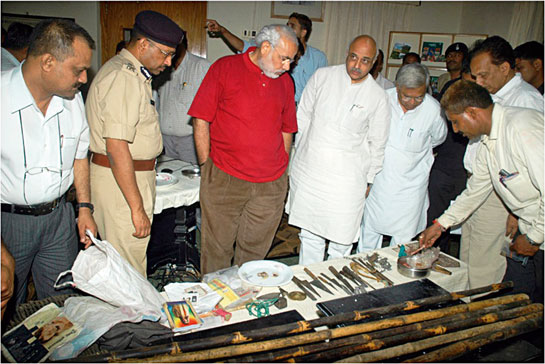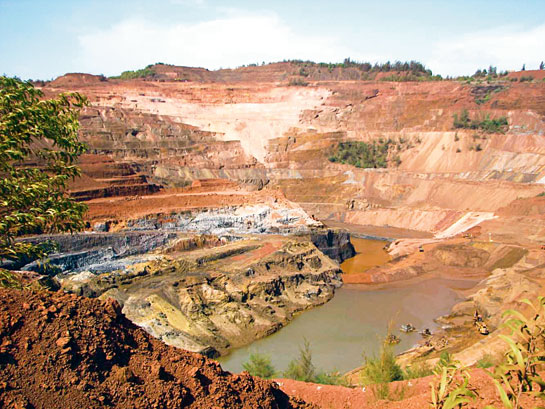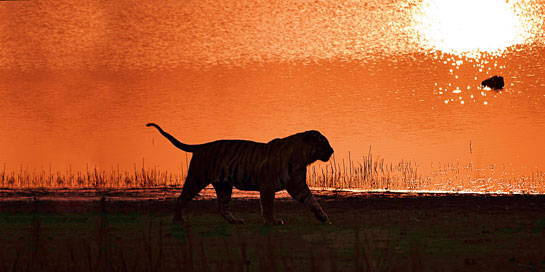Narendra Modi's Development Plan? Will It Hang India's Wildlife?
First published in Sanctuary Asia,
Vol. 34
No. 6,
June 2014
By Bittu Sahgal
 Photo: Varun Thakkar.
Photo: Varun Thakkar.
Perhaps not, suggests Bittu Sahgal, Editor, Sanctuary Asia, in this open letter to Prime Minister Narendra Modi who won a stunning political mandate that offers him a chance to alter our destiny and steer India away from the ecological precipice towards which over a billion people are resolutely headed.
On the other hand, Sahgal points out, Modis fabled business-like ability, could actually sink us all… if the ‘smart-government he heads subscribes to “the only good forest is one that is turned to cash" philosophy of his predecessor.
Dear Prime Minister Modi,
Congratulations on your unprecedented victory. You have an onerous responsibility on your shoulders and every sensible person and organisation should be prepared to work with you to stabilise the good ship India, which has been set adrift at the hands of inept captains in the past few decades.
India has much to teach the world about sustainability, but in the recent past, rather than export our own sustainable attitudes we appear to be importing false ambition, which seems to suggest that consumerism and happiness are two sides of one coin.
This misinterpretation of reality could well destabilise India as Mahatma Gandhi feared when Nehru outlined his vision for India in 1947. Frankly, no one individual can hope to tackle the multifarious challenges ahead, not even with the massive mandate you have brilliantly won. All of us - individuals, families, neighbourhoods, villages and cities will need to unite as never before behind the common goal of restoring health to our nation. If we fail, all our development ambitions will probably remain out-of-reach.
Prime Minister, the eyes of India and the world are upon you and your articulation of ‘Smart Governance will surely go down well given the dismal record of your predecessor. But smart governance must be measured in the long-term. Which is why people ask: “Will Narendra Modi steer Indias craft, away from the rocks, re-plot the faulty chart, repair the sails, motivate the crew, and begin the purposeful journey back to safe harbour? Or will he in fact pilot India at greater speed towards the rocks?"
We have not heard you speak on television in the lead up to the elections on the issue of wildlife, nature conservation and climate change; however your Gujarat officials point to the success of the Gir Lion Project as evidence of your determination and ability to protect wild nature. Undoubtedly, if you do for the tiger what you did for the lion, Panthera tigris will be safe. But for this welcome event to take place, your advisors, those who financed your campaign and those who have access to you on a daily basis, need to be viscerally convinced that there can be no profit in waging war against nature for short-term economic gain.
In a different context, when representatives of Sanctuary Asias one-million-strong Kids for Tigers met former Prime Minister Atal Bihari Vajpayee in January 2002, they found immediate resonance with him when they pointed out: “If India keeps destroying its forests and Raja Dashrath were to ask Lord Ram to go on vanvaas for 14 years today… which extensive forest could you possibly find for Ram, Lakshman and Sita?" His response was appreciative and pensive: “Its true. Forests are the true temples of Ram." Soon after he addressed the nation on the issue of forests and wildlife in his capacity as Chairman of the Indian Board for Wildlife stating: “Bachhe jab jagrut ho gaye, to basurg log kyon so rahe hain?" (the children have woken, why are adults still sleeping?).
 Photo: Dr. Anish Andheria.
Photo: Dr. Anish Andheria.
HOPE AGAINST HOPE
This said, permit me to outline some random thoughts based on what is publicly known about your positions on development. It is my fond hope that you might take stock of the runaway train that is India, and suitably temper the long list of developmental (industrial) demands sitting in your in-tray, with ecological pragmatism.
Minimal Government, Maximum Governance: This is your promise. Interestingly, this is almost precisely what Project Tiger steadfastly advocated for tiger conservation four decades ago. The strategy won widespread global respect for India, which was credited with implementing ‘the most successful conservation project in the world. But the ‘do little in tiger habitats and allow little to be done beyond protection strategy was virtually abandoned in the late 1980s when economists under the influence of the World Bank began to lay industrial claim to wildlife habitats, thus swallowing virtually all past gains, and leaving the tiger in a more precarious position than ever before. If the strategy of protecting ecosystems to save wild species returns to centre stage, Indias precarious ecological circumstances could possibly be repaired and in the process our water, food and economic security would be dramatically enhanced.
Climate Change Adaptation and Mitigation: You have wisely promised to encourage research and its applications to meet the challenges of climate change and to forecast, prevent and mitigate natural hazards, including floods, cyclones, earthquakes, droughts and landslides. I am not sure, however, that your advisors have nailed the connection between natural ecosystem restoration (dependent on species protection), carbon sequestration and flood and drought control. I also wonder if Indias economists, under your new leadership, will acknowledge that the most economical strategy to safeguard the lives and livelihoods of 1.3 billion people against the worst impacts of climate change involves investing massively in ecosystem renewal (which will bring carbon down from the atmosphere). I have no doubt that both wind and solar energy will get a boost, but I wonder if your advisors will ensure that wind and solar are sited away from critical biodiversity areas and whether they will grasp the contradiction inherent in investing in preventing Himalayan glacier-melt on the one hand and tripling Indias coal-fired thermal plant capacity on the other.
Energy: Your mantra to generate more, use rationally and waste less is excellent. Clearly there cannot be any guillotine applied on the extraction of coal, oil and gas either. But the previous government had very contradictory plans. Mining coal from the tiger corridors of the Greater Tadoba Landscape, for instance, which is suicidal as it seriously erodes Vidarbhas water security, magnifies human-animal conflicts and kills wildlife tourism. Surely a better option might be to invest in power plants and dams by retrofitting turbines, improving transmission efficiency and reforesting watersheds? These steps might yield greater and quicker results than opening up virgin forests, wetlands, coasts and mountains to projects whose gestation period and damage quotient would by definition be much longer.
National Security Council: Your determination to make this the hub of all sector-related assessments is very welcome, as is your determination to hold it accountable for real-time intelligence dissemination, through digital and cyber security. Perhaps you might be able to impress on them what we have thus far been unable to… that the illegal wildlife trade is the third largest in the world after arms and narcotics and that the operatives of all these three, plus human trafficking, share common resources. In other words, I hope you will be able to plug the gaping hole in our internal security caused by the wholly inadequate budgets allocated to anti-poaching, wildlife crime and forest protection. Indian examples of the wildlife trade financing anti-national activities are rife - Veerappan and the LTTE (ivory, sandalwood) in Sathyamangalam, the Jammu Kashmir Liberation Front (JKLF) along the India-Pakistan border (shahtoosh and snow leopard pelts), Dawood Ibrahim in Bihar and Chattisgarh (katha trade), armed Maoist insurgents in North Telengana (tiger bone trade), Bodo Liberation Front (rhino horn and ivory), and the Karbi Longri N.C. Hills Liberation Front or KLNLF (rhino horns from Kaziranga). Virtually every terrorist and insurrectionist organisation easily finances itself by linking with poachers (Sanctuary Vol. XXXIII No. 3, June 2013), timber smugglers and miners who operate with impunity in unprotected wildlife areas. Hopefully, you will be able to put a halt to this and thus shore up Indias internal security.
Science and Technology: You have consistently promised to build “world class, regional centres of excellence of scientific research in the field of nanotechnology, material sciences, and thorium technology." Hopefully your advisors will recognise the wisdom of investing in conservation biology, a neglected branch that can help planners come to grips with out-of-whack planetary systems that are destabilising our climate today. The worry is that good science is ignored when it clashes with short-term financial gains. This has been the greatest disappointment of young biologists who must either ‘cooperate or have their research permissions cancelled.
 Photo Courtesy: Keshav Kumar.
Photo Courtesy: Keshav Kumar.
WHICH WAY WILL THE WIND BLOW?
What was listed above represents fond hope. Here are some dark fears:
Free-flowing Rivers: We hear of two ‘sea-dams, one in the Gulf of Kutchh and the other in the Gulf of Khambat, Kalpasar. The latter undertaking seeks to block the fresh water flow from rivers including the Sabarmati, Mahi, Dhadhar, Narmada (through a diversion canal), Limdi Bhogavo, Sukhbhadar, Utavali, Keri and Vagad. We understand that the Dutch are pushing for Kalpasar and a separate ministry in Gujarat is being created for its implementation. The worry is that this will kill every last mangrove along the coastline and drown untold small and large coastal land holdings. Your advisors will claim that rehabilitation will be handled fairly and aquaculture in the huge freshwater reservoir will more than compensate for the loss of mangrove-breeding grounds. But the experience across the globe with coastal aquaculture has proven to be (ecological and financially) disastrous. And forced displacement has always created poverty and set brother against brother. What is more, the Kalpasar Project would threaten Saurashtras famous Velavadar Sanctuary, with its blackbuck and wolves that cannot hope to adapt to altered bio-climatic, and much more heavily commercialised land use. And if the Kutchh dam is ever built, Flamingo City (which rivals Lake Nakuru in Africa) will vanish altogether. The wild asses (ghudkar or khur) in the Rann of Kutchh will also lose the ecological niche they have enjoyed for millennia.
Linking Indian Rivers: This will involve roughly 3,000 small and large reservoirs and lead to forest loss and human displacement on a scale that the planet has never witnessed. This would be three to five times greater than Chinas Three Gorges Dam, which is currently causing havoc by starving one set of people of water and delivering massive floods to another set of downstream populations. In India, the first forest to go will be the Panna Tiger Reserve, which feeds the Ken river, and where local extinction of tigers was recently reversed. The logic in building 30 links, 3,000 small and large reservoirs, 12,500 km. of canals to link 36 Himalayan and Peninsular rivers to effect 178 km3 of inter-basin water transport is beyond understanding.
Himalayan Dams: As many as 300 large dams plus innumerable smaller impoundments are planned for the Himalaya at a cost exceeding four lakh crore rupees. Proponents claim this will make India a surplus energy nation that will actually export electricity. But the river flow data on which such extravagant claims have been made are outdated. The glaciers that engineers and economists say will feed these dams have either partially melted or are fast melting. This one fact alone renders any money invested near-useless even before completion. What is more, China is poised to divert much of the Brahmaputra river flow, a major catastrophe. If such huge sums are borrowed and sunk, India will be caught in a debt trap of our own making because we will have invested in junk assets.
 Photo: Gaurav Shirodkar.
Photo: Gaurav Shirodkar.
INDIA SPEAKS
Honorable Prime Minister, I asked a range of very credible environmentalists and scientists for their prognosis for Indias wildlife under your Prime Ministership. Some of their views might interest you.
Himanshu Thakkar of the South Asian Network on Dams, River and People feels that: “Environmental and development governance in India is plagued by lack of democracy. There is very little transparency, flimsy participation and non-existent accountability. Making governance top-down renders it undemocratic and amenable to corruption and would have the effect of destroying our rivers, waterbodies, forests and biodiversity, as also the livelihoods of millions connected with these resources."
Given their experience with Dr. Manmohan Singhs government many believe your leadership will actually deliver India from the jaws of ecological disaster. Valmik Thapar, tiger defender, writes: “I am not an astrologer who can predict the future. There will be enormous changes in wildlife and forest policy and governance. Narendra Modi believes that tourism is a priority sector. Wildlife tourism will be a critical component of this belief. Therefore I doubt if his development agenda will hang wildlife. Innovative wildlife tourism models may in fact boost it. Time will tell."
His view is more or less in consonance with that of Dr. Ullas Karanth, one of Indias most respected tiger experts: “On balance, I believe that well-conceived, non-statist economic growth and development models can reduce poverty, shift people away from land-based professions and dependencies that are severely damaging natural areas and wildlife. The resulting demographic transition can wean rural folks away from hunting wild meat for protein and other “cultural traditions" decimating wildlife as well as feeding the massive global wildlife trade. On the other hand, the problem from the potential habitat impacts of the mindless shoddily planned “development projects" - including the unrecognised danger from micro-hydel, wind power and solar projects that many “greens" love - may get even worse than they did during UPA regime. Pragmatic conservation approaches may lead to gains for wildlife, whereas the standard ‘green Luddite sweeping agendas may not work: I am waiting to see how this will unfold..."
Debi Goenka, Conservation Action Trust, is less optimistic: “If Narendra Modis development plan follows the old India Shining model (whereby all environmental laws and regulations would be rendered ineffective), it will destroy Indias natural resource base that keeps 400 million Indians alive. The loss of our wildlife will bea comparatively minor sacrifice at the Modi-Adani altar of devilopment (his spelling!)."
Belinda Wright, Executive Director, Wildlife Protection Society of India is more positive and said: “The people of India have now overwhelmingly put their trust in the hands of the BJP. Yes, one of their main objectives in their manifesto is development. But their manifesto also talks about “safeguarding our tomorrow," and they specifically mention “protecting the existing forests and wildlife reserves". I have faith that they will have the wisdom to do just that… there are difficult days ahead but Indias heart is its wildlife, and I do not believe our new leaders will break it."
In closing Honorable Prime Minister, may I therefore state that the lion, tiger, turtle, butterfly, orchid, mudskipper and one-horned rhino will need every helping hand imaginable to survive the development ambitions of a nation that believes that economic ambitions can somehow be fulfilled even at the cost of its wildernesses. We know that is not possible and our hope lies in the young people who voted your government to power who will hopefully convince your advisors that Indias national interests in an era of climate change will be best served by restoring the wild rivers, grasslands, forests, mangroves, coasts, wetlands and mountains, which are under unmitigated assault. That you will move us away from the subcontinents biological-climate precipice. All this to improve the human condition - particularly the 1.3 billion Indians who have already begun to bear the brunt of climate-triggered aggression at the hands of nature wronged.
 Photo: Ashish Dhamankar.
Photo: Ashish Dhamankar.
So there we have it Honorable Prime Minister. You have won an admirable mandate and have infused the nation with hope. What remains now is for you to apply your resolve to protecting the future, way beyond your term of office. Therein lies the mark of a true leader.
With hope, expectation and a promise of constructive engagement,
Bittu Sahgal, Editor, Sanctuary Asia
|
TENETS OF GOVERNANCE SUPPORTED BY PRIME MINISTER NARENDRA MODI
1. Remove bottlenecks and missing links in all sectors, activities and services
Forest and wildlife protection agencies must be financially and administratively enabled so missing links can be filled. Right now the order of the day is to create bottlenecks in the implementation of clearly stated environmental policies whose mission is seen as counter-productive by politicians and businessmen with clear short-term visionand goals.
2. Focus on proper planning and execution for right outcomes
The Ministry of Environment and Forests needs to work to protect forests and not act as a clearing house for commercial projects, many whose costs are far greater than their claimed benefits. Advice to create connecting corridors and other conservation and environmental initiatives by the protection wings of government must not be overruled by ‘more powerful ministries seeking short-term economic gain as this has, and would continue to, deliver precisely the wrong outcomes.
3. Strive for scale and speed with futuristic vision
Several recommendations and policies pertaining to environmental protection have remained in cold storage for decades. Instead of expanding capacities to protect Indias natural resources, we have seen the systematic dilution of laws and policies and the purposeful placement of hurdles in the way of implementation of clearly agreed upon future visions.
4. Build institutions for today and tomorrow
At this point, institutions set up to protect natural India and its environment are being sabotaged through political interference. Cases in point are the various State Pollution Control Boards, the Regional Offices of the Ministry of Environment and Forests, the Wildlife Institute of India, the Zoological Society of India and the Botanical Society of India. All are independent on the face of it but their institutional status is ruthlessly undermined by political interference, which openly overrules scientific advice. |


 Photo: Varun Thakkar.
Photo: Varun Thakkar. Photo: Dr. Anish Andheria.
Photo: Dr. Anish Andheria. Photo Courtesy: Keshav Kumar.
Photo Courtesy: Keshav Kumar. Photo: Gaurav Shirodkar.
Photo: Gaurav Shirodkar. Photo: Ashish Dhamankar.
Photo: Ashish Dhamankar.